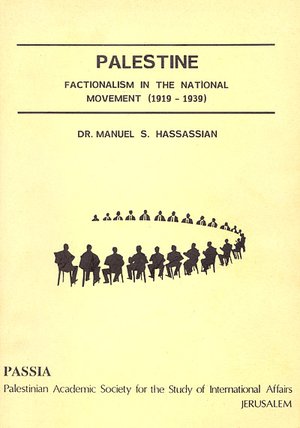Palestine: Factionalism in the National Movement (1919 - 1939)
This study examines the internal struggle among the leading Palestinian families for the attainment of power, and leadership of the Arab national movement in Palestine. From the first years of the British Mandate in Palestine, the traditional leadership of the Arabs was split between the Husseinis and the Nashashibis. The divisive nature of Arab leadership had its effect on the whole of the Arab national movement. The book discusses the rise of Zionism and Palestinian nationalism, the development and roles of the rivalry majlesiyoun's leadership and the mu’arada, as well as their internal political struggle during 1929-32 and their roles in the major political crises of 1933-1939.
Overview
This study examines the internal struggle among the leading Palestinian
families for the attainment of power, and leadership of the Arab national movement
in Palestine. From the first years of the British mandate in Palestine, the traditional
leadership of the Arabs was split between the Husseinis and the Nashashibis. The
divisive nature of Arab leadership had its effect on the whole of the Arab national
movement. In essence, that movement was never united or strong enough to
confront its British and Zionist adversaries. However, part of this problem was the
outcome of the existing social structure which was unproductive as well as rigid.
Nevertheless, Western influence in the form of secularism and modern
development did have effect on the demography of Palestine many years before the
British created it as a separate political entity. A new urban elite had come to being
towards the end of the nineteenth century. During the mandate, this elite became
politically influential, causing the traditional elites in the villages to feel resentful
and insecure. Not until the 1930's was the urban elite able to dominate the politics
of both the rural and urban populations and become in effect the national
leadership of Arab Palestine.
The British, who naturally wanted to control the country, exploited almost every
aspect of the demographic and social cleavages existing in Palestine. They
encouraged the establishment of "peasant" type of political parties hoping such
political organizations would prevent the union of rural and urban elites into what
might become a viable and genuine national movement.
However, the rivalries between the Husseinis and the Nashashibis remained the
British best hope for a weak and ineffective national movement. Unfortunately, the
Palestinian Arabs could not escape their traditional rivalries. The Palestinian
national movement fell victim to internal divisions and political fragmentation. At
times, Arabs fought Arabs while their Zionist enemy confronted them with unusual
stubbornness and determination to succeed in their ultimate goal of creating a
Jewish state in Palestine.
In fact, the British policy of "divide and rule", succeeded and the rivalry between
the two families took a sharp turn during the first decade of British mandate. These
families manipulated all the ties of kin, class and patronage to win over new
supporters. Unfortunately, the traditional leadership did not realize in the 1930's
that the future did not belong to it for the Arabs would lose Palestine partly in
1948. A Jewish state would be established in most of the country and the rest
would go under Jordanian and Egyptian rules. Worse yet, down this pipeline the
future looked gloomier. The whole of Palestine would go under Jewish rule and
there would be no assurances that stability in the region of peace might one day
prevail.
Introduction
The Rise of Zionism and Palestinian Nationalism
The Zionist Movement
British Wartime Promises
The Development of The Majlesiyoun's Leadership of Arab Palestine
The Palestinian Movement in its Early Stages of Development
The Palestinian Congresses
The Emergence of the Husseinis As the Leading Family of Palestine
Early Opposition to Haj Amin's Leadership
The Development Of The Mu'arada In The 1920's
The Nashashibi Family
The Other Families in the Mu'arada
Sources of Strength
Sources of Weakness
Groups Affiliated with the Mu'arada
The Mu'arada's Role in the Specific issues of the 1920's
The Mu'arada And the Majlesiyoun in the Internal Political Struggle (1929-32)
The 1929 Wailing Wall Incident and the Outbreak of Violence
The Majlesiyoun and the General Islamic Congress in Jerusalem
(1931)
The General Islamic Congress (1931)
The Congress of the Palestine Muslim Nation
The Role of Mu'arada in the Major Political Crises of 1933-1939
The Decline In The Influence of Traditional Groups
The Decline In The Influence of the Mu'arada
The 1933 Disturbances
The Proliferation of Political Parties
The Mu'arada's NDP and The Legislative Council Proposal of 1935
The Failure of the Revolt and the Downfall of the Traditional Leadership

